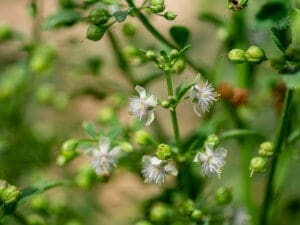 Working with this species in the Peruvian Amazon has been one of more exciting discoveries during our stays in traditional villages. The locals have many colloquial names for this fine plant owing to its wide use and effectiveness. While we source directly from Peru this herb can be found throughout the tropical and subtropical the Americas and Asia,1 Vassourinha is a tropical flowering herb related to foxglove and grows up to a meter in height with square stems and simple leaves.
Working with this species in the Peruvian Amazon has been one of more exciting discoveries during our stays in traditional villages. The locals have many colloquial names for this fine plant owing to its wide use and effectiveness. While we source directly from Peru this herb can be found throughout the tropical and subtropical the Americas and Asia,1 Vassourinha is a tropical flowering herb related to foxglove and grows up to a meter in height with square stems and simple leaves.
Depending on the amount of moisture found in the surrounding soil, the plant may be considered annual or perennial. Regardless, propagation occurs via tiny, obconical shaped seeds.2 The plant is light and delicate, with thin leaves and white or pink flowers growing singly or in pairs of two.3 In fact, Vassourinha resembles a plant you might find popping up in an overgrown flower garden or along a meadow path.
Traditional Uses of Vassourinha
Vassourinha’s formal name is Scoparia dulcis. Commonly this plant is referred to as sweet broom because its bushy stems have been traditionally used to make floral bundles or brooms to sweep rooms and cabinets. The botanical has been used in either its fresh or dried form to repel insects and cleanse the intestinal tract.4
Indigenous populations used this plant for much more than sweeping, though. In Ecuador, indigenous tribes brewed a tea from the entire plant to reduce swellings, and ease minor aches and pains. Indigenous tribes of Guyana used a decoction of the plant for washing wounds because of its antiseptic properties, used it to create a soothing bath to cool the body, and created a poultice for other wellness treatments. Stories like this throughout South American history are plentiful.5
Modern Uses of Vassourinha
While some people may consider Vassourinha a weed,6 for others this botanical is sought after as a wellness herb to alleviate many conditions too numerous to mention.7 Modern-day use of Vassourinha is widespread.8 In fact, it’s quite impressive how much benefit this tiny botanical may provide. There is a continued examination of the potential of Vassourinha in universities around the world.
Phytochemical properties of Vassourinha
Scoparia dulcis is a source of flavones, terpenes and steroids, phenols, tannins, saponins, amino acids, coumarins and carbohydrates. Chemicals include scopadulcic acids A and B, scopadiol, scopadulciol, scopadulin, scoparic acids A – C and betulinic acid. Other chemicals found in studies include: acacetin, amyrin, apigenin, benzoxazin, benzoxazolin, benzoxazolinone, cirsimarin, cirsitakaoside, coixol, coumaric acid, cynaroside, daucosterol, dulcinol, dulcioic acid, gentisic acid, glutinol, hymenoxin, linarin, luteolin, mannitol, scoparinol, scutellarein, scutellarin, sitosterol, stigmasterol, taraxerol, vicenin, and vitexin.9 A 1979 study published in “Current Science” identified the existence of flavonoid glycoside.10 Flavonoids have antioxidant activity regulating cellular activity and fighting off free radicals that cause oxidative stress.11
Interested in trying Vassourinha for yourself?
Herbs-America provides high-quality Vassourinha extract for system restoration to improve flexibility and ease minor pain. Purchase Vassourinha from our online store to start adding this herbal extract to your daily regimen. Simply add 10-20 drops once or twice daily in water or as recommended by your health care practitioner.
Learn more and save more!
Stay up-to-date on the latest specials, news, and information from Herbs America. Sign up to receive our newsletter and receive 15% off your first order! CLICK HERE to get started!
Mishra MR, Mishra A, Pradhan DK, Panda AK, Behera RK, Jha S. Antioxidant Activity of Scoparia dulcis Linn. Indian J Pharm Sci. 2013;75(5):610-614. ↩
“Riceweeds en-Plantaginaceae – Scoparia dulcis L.” PlantNet website: http://publish.plantnet-project.org/project/riceweeds_en/collection/collection/information/details/SCFDU ↩
“Scoparia dulcis-L.” Plants For A Future website: https://pfaf.org/user/Plant.aspx?LatinName=Scoparia+dulcis ↩
Tropical Plants Database, Ken Fern. tropical.theferns.info. 2020-10-12. <tropical.theferns.info/viewtropical.php?id=Scoparia+dulcis> ↩
Taylor, Leslie. The Healing Power of the Rainforest Herbs, 2005, Text reprinted at: https://rain-tree.com/vassourinha.htm. ↩
Tropical Plants Database, Ken Fern. tropical.theferns.info. 2020-10-12. <tropical.theferns.info/viewtropical.php?id=Scoparia+dulcis> ↩
“Scoparia dulcis-L.” Plants For A Future website: https://pfaf.org/user/Plant.aspx?LatinName=Scoparia+dulcis ↩
Mishra MR, Mishra A, Pradhan DK, Panda AK, Behera RK, Jha S. Antioxidant Activity of Scoparia dulcis Linn. Indian J Pharm Sci. 2013;75(5):610-614. ↩
Paul, Meera. “SCOPARIA DULCIS: A REVIEW ON ITS PHYTOCHEMICAL AND PHARMACOLOGICAL PROFILE.” International journal of sciences (2017): 18-22. ↩
Ramesh, P., et al. “FLAVONOIDS OF SCOPARIA DULCIS AND STEMODIA VISCOSA.” Current Science, vol. 48, no. 2, 1979, pp. 67–67. JSTOR, www.jstor.org/stable/24081440. ↩
“What Are Flavonoids? Everything You Need to Know.” Heathline Website: https://www.healthline.com/health/what-are-flavonoids-everything-you-need-to-know ↩

Reader Interactions